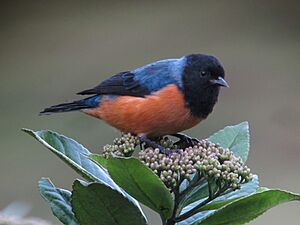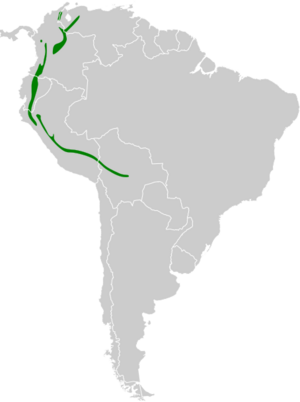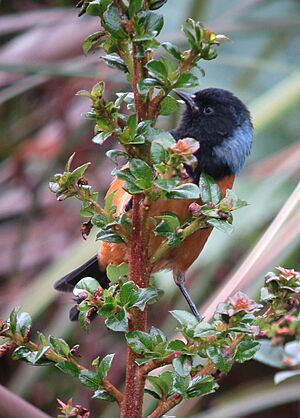Blue-backed conebill facts for kids
Quick facts for kids Blue-backed conebill |
|
|---|---|
 |
|
| C. s. sitticolor seen in Caldas, Colombia on top of a Chilca plant | |
| Conservation status | |
| Scientific classification | |
| Genus: |
Conirostrum
|
| Species: |
sitticolor
|
 |
|
The blue-backed conebill (Conirostrum sitticolor) is a small, colorful species of bird. It belongs to the family Thraupidae, which includes many South American tanagers.
You can find this bird in several countries in South America. These include Bolivia, Colombia, Ecuador, Peru, and Venezuela. It likes to live in warm, wet montane forests, which are forests found in mountainous areas.
Contents
About the Blue-backed Conebill
How Scientists Name Them
The blue-backed conebill was first described by a French bird expert named Frédéric de Lafresnaye in 1840. He placed it in a group called Conirostrum, which includes other birds known as conebills.
At first, this bird was called the Purple conebill. Some of its slightly different types, or subspecies, were even thought to be completely different species. Today, scientists recognize three main subspecies of the blue-backed conebill. These subspecies are found in different parts of the bird's range.
What Does It Look Like?
The blue-backed conebill is a small bird, weighing only about 11 to 13 grams. That's about as much as two quarters!
While each subspecies looks a little different, they all share some key features. They all have some black on their head. Their back, rump, and tail are blue. Their belly is a bright orange color.
For example, one subspecies, C. s. sitticolor, has a completely black head and throat. Its wings are also black. Another subspecies, C. s. cyaneum, has a black cheek and chin. But it has a blue stripe behind its eye and blue wings. The third subspecies, C. s. intermedium, looks like a mix of the other two.
How It Behaves

Like other conebills, the blue-backed conebill loves to eat insects. It mostly searches for bugs high up in the tops of trees.
You'll often see this bird flying with other types of birds. They form what are called mixed species flocks. These flocks often include other insect-eating birds like the Pearled treerunner and the Streaked tuftedcheek. Scientists have noticed that the blue-backed conebill especially likes to hang out with other conebills. These include the Rufous-browed conebill and the White-browed conebill.
Not much is known about how these birds build nests or raise their young. Scientists are still studying these parts of their lives.
Where It Lives
The blue-backed conebill lives along the Andes mountain range in South America. You can find it from northern Colombia and Venezuela all the way down to central Bolivia.
In Venezuela, it lives in the Cordillera de Mérida and Sierra de Perijá mountains. In Colombia, it is found in the Central and Eastern Andes mountain ranges. It also lives in the Sierra de Perijá.
In Ecuador, you can find it in the central part of the country. This is from the border with Colombia in the north to the border with Peru in the south. One subspecies, C. s. sitticolor, continues along the western slopes of the Andes into northern Peru. Another subspecies, C. s. cyaneum, lives on the eastern slopes of the Andes. It ranges from northern Peru into central Bolivia.


